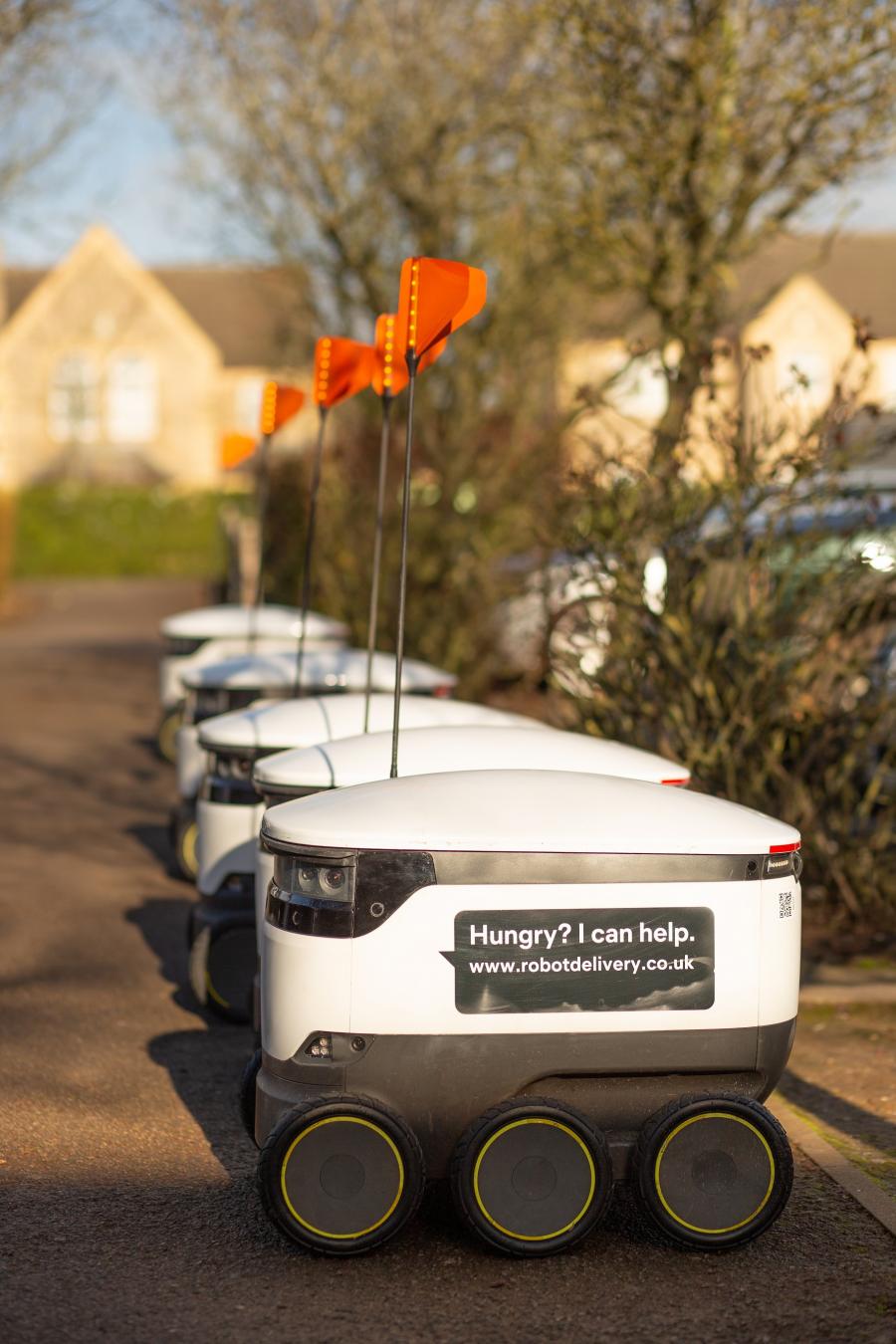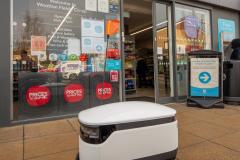1. What are the benefits of Starship Technologies' Personal Delivery Devices ("PDDs")?
PDDs are revolutionising the local delivery of goods for businesses and consumers. Rather than relying on car-based shopping trips or delivery trucks, PDDs offer consumers a low-cost and convenient alternative – all while using less energy and emitting zero CO2.
For consumers who are transit-dependent, non-ambulatory or reside in neighbourhoods with limited shopping choices, PDDs represent a new and cost-effective option.
More recently, Starship is proud of the role that our PDDs have played in permitting contactless deliveries during the COVID-19 pandemic. Our service is supporting social distancing, as well as providing much-needed support of local businesses and their staff. We are especially pleased to provide free delivery services to our national heroes within the NHS.
2. How does a customer obtain delivery services from a PDD?
The process is simple. Customers use Starship's mobile app to order their goods from participating businesses and select the time and destination for the delivery. The customer is then notified through the mobile app when their goods are ready for delivery and can track the movement of the PDD through the mobile app. Once the PDD arrives at its destination, the customer is notified. The customer can then retrieve their goods by unlocking the lid of the PDD by pressing the unique 'unlock' button on the Starship mobile app.
3. What types of items will a PDD deliver?
Starship's PDDs have many possible applications, including restaurant delivery, grocery and retail delivery, and parcel delivery.
4. Are the PDDs safe for pedestrians and other users of public space?
Absolutely! Our priority is the safety and security of the communities we operate in. Our PDDs are low-mass, slow-speed devices that travel predominantly along pavements using mapping, navigation and sophisticated obstacle avoidance technology. This technology allows the PDDs to identify objects in their vicinity and make the necessary course corrections to avoid the objects. When an object is adjacent to the PDD, but not in front of it, the PDD reduces its speed. When an object is in front of the PDD, the PDD will come to a complete stop. In addition, the PDDs are constantly monitored by a remote operator who is capable of
assuming operational control over the devices at any time.
5. How do the PDDs work?
PDDS use proprietary mapping, navigation and sophisticated obstacle avoidance technology to maneuver. The devices are equipped with three layers of obstacle avoidance, which ensures their safe operations, including 9 cameras (3 front, 4 sides, 2 rear), 8 ultrasonic obstacle detectors (front), a radar, 2 Inertial Measurement Units and a GPS. The PDDs are capable of identifying objects up to 300 feet away and, as previously mentioned, making necessary course corrections to avoid the object.
6. How do PDDs safeguard and serve individuals with physical or visual disabilities?
Accessibility has been a central focus of Starship’s since its founding. The Company is committed to accessibility as it relates to both operations and service. For example, if a PDD encounters an individual in a wheelchair, the wheelchair is identified using both sonic sensors and computer imaging. Once the wheelchair is identified, a remote operator is pinged, who can then assist the PDD in steering away from the individual in the wheelchair, as needed. Simultaneously, the PDD will notify the individual that it is going to move out of the way. For individuals with visual disabilities, the PDDs are programmed to identify and avoid pedestrians. As previously mentioned, the PDD will stop if an object appears in front of it and slow down if an object is alongside of it. If a PDD comes to a stop, for any reason, a
remote operator is pinged and can immediately take control of the device and navigate it, using low-resolution cameras. Regarding Starship’s service, the company’s app is fully compliant with Web Content Accessibility Guidelines ("WCAG") 2.0 AA. Over the past months, Starship has been working to transform its app from the ground up, enhancing accessibility and enabling smoother navigability for the visually impaired. The company aims to test and improve the new features once the COVID-19 public health emergency subsides, including the labelling of all elements for VoiceOver. Starship has also created Predefined Pickup Spots, which will soon
work with voice control in the app, enabling visually impaired customers to order food to a fixed location. Starship's website also features a number of testimonials by individuals with disabilities who utilise the company's service. Find out more here.
7. Do Starship's PDDs ever exceed 4 mph?
No.
8. Are PDDs illuminated?
Yes. Starship's PDDs are equipped with several lights that are always lit, including: (i) an illuminated flag that stands nearly 4 feet from the ground, (ii) red lights across the rear of the device, and (iii) white lights across the front of the device. When operated between sunrise and sunset, PDDs are visible from all sides in clear weather from a distance of at least 500 feet.
9. What happens if a PDD becomes immobile (breaks down, gets stuck, etc.) while on a delivery?
Starship's PDDs are constantly monitored by remote operators who are capable of assuming control over the device at any time. If a PDD comes to an unscheduled stop, a remote operator is immediately pinged and will assume control over the device. If a remote operator is unable to resolve the situation, a Field Assistant is dispatched from the adjoining Operation’s Centre within minutes of an issue arising.
10. How do I contact Starship if I have a question or concern?
Starship maintains a 24/7 customer service line to support its local operations.
Phone: +44 7588 732673
Email: [email protected]
11. How will Starship Technologies prevent PDDs from being used for unauthorised purposes and/or from being vandalised?
Starship's PDDs are always under the control of a Starship PDD operator. Starship's PDDs cannot be used without the consent and knowledge of the company. In fact, only businesses, which have a contractual relationship with Starship, will be able to offer PDD services. Importantly, even these businesses have no operational control over the PDDs. Starship's software and PDD operators guide the devices – no one else!
The cargo bay of each PDD is locked and secured during transport. Only individuals who are known to the company, will be able to receive, open, and return PDDs with the use of their mobile technology. As mentioned above, PDDs are constantly monitored and equipped with 9 cameras and an audio communication system. Any improper conduct will be detected immediately.
12. How does Starship protect customer information and the privacy of the general public?
Starship never shares customer information and does not store such information on its PDDs. Although the PDDs are equipped with 9 cameras, Starship minimises the amount of information that it collects. First, when the PDD is operated by a human operator, the images are transmitted exclusively via a lower resolution feed, which is further obfuscated to conceal individual identities. Second, high-resolution images, which are collected while the PDD is in autonomous mode, generally remain on the PDD for a very short duration and are then discarded. There are two exceptions: (i) safety and security, e.g. emergencies, vandalism, etc. and (ii) PDD system improvement, e.g. machine learning. In both instances, the information is transmitted in an encrypted form to Starship, where it resides on a segregated system with restricted employee access.
Starship maintains an audit trail of those employees who review these images and the reasons for this review. In all cases, the images stored are brief snapshots and human images are obfuscated. For more information, Starship's privacy policy can be found here.
13. How does Starship clean PDDs to protect customers and partners from coronavirus?
Starship operators and/or partners clean the PDDs before and after every delivery, with an emphasis on high areas of touching. Moreover, all persons touching the PDDs, including anyone handling food, are required to wear gloves. Every evening the PDDs undergo additional cleaning protocols, including a thorough cleaning of the PDD’s lid handle and a careful cleaning of the PDD’s thermal bags.
It is worth noting that Starship's cleaning procedures were reviewed by the Arizona State University Environmental Health and Safety Biosafety Department to ensure that they meet current COVID-19 guidance.
14. How many commercial deliveries has Starship completed?
Starship Technologies' PDDs have travelled more than 1 million autonomous across the globe, completing over 300,000 commercial deliveries and reducing CO2 emissions by tens of thousands of Kgs.


